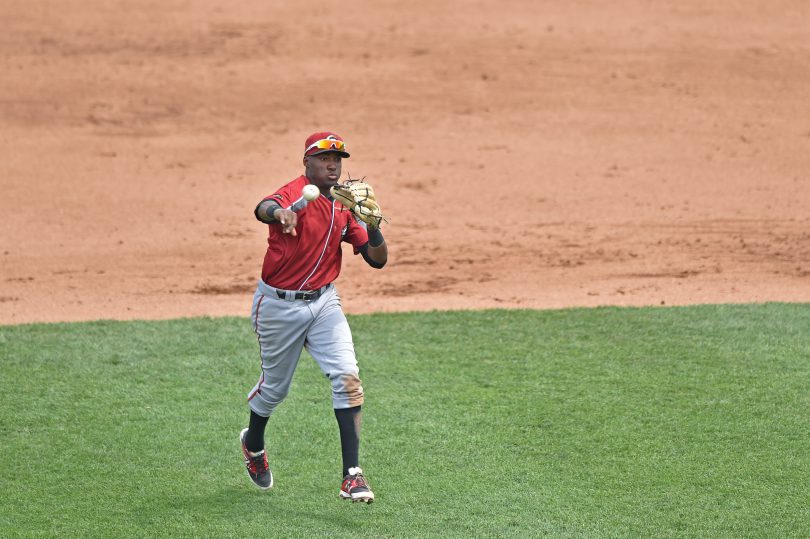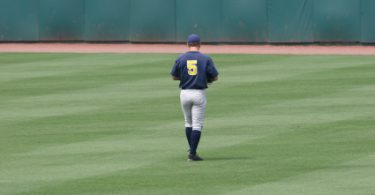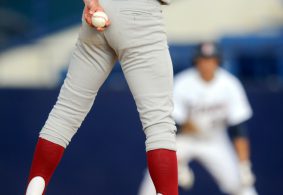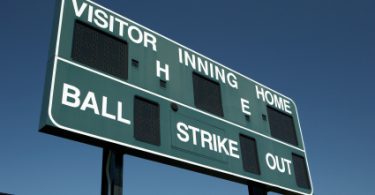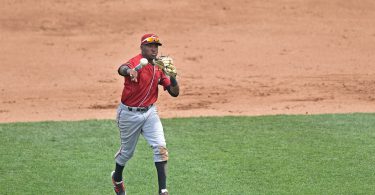The Situation:
There’s a runner on 1st with 1 out in the top of the 8th inning of a 9-2 ballgame. The offense is running away with the game. The left-handed hitter digs in against the righty reliever, down in the count 0-2.
The Play:
The catcher raises his glove to signal for the high fastball as the pitcher completes his delivery. The pitch, which is supposed to be up and on the inner half, runs back over the plate. Despite being elevated above the zone, the lefty is able to go with the pitch and slap a line drive down the left field line. The left fielder runs straight across towards the foul line, hoping to cut the ball off. As he approaches the ball, he works to get his feet underneath him and attempts to field the ball with a forehand just on the outside of his left foot, sweeping his glove across the path of the ball.
The Outcome:
Unfortunately for the outfielder, he has misjudged the speed of the ball and it rolls just outside of his glove untouched and goes all the way to the wall. The runner from first comes around to make it a 10-2 game and the batter ends up on third base.
What Went Wrong:
Infielders discuss different ways to approach and field the ball on a daily basis. Can the same be said for outfielders? It should. Even though they have more time to react and gather balls, outfielders face many different plays on balls hit to them on the ground, some of which force them to cover a lot of ground and field the ball on the run, like this one. These plays are difficult and need to be practice regularly. On this play, the outfielder’s mistake is approaching the ball with the wrong fielding position.
When a defender approaches a ground ball to field it, the ball will be coming to him in one of 3 lanes. If he can square the ball up between his feet, it’s a middle lane play, often the most routine. If he has to reach to his throwing side, it’s in the backhand lane. Finally, if it’s outside his body to the glove side, it’s in the forehand lane.
Many outfielders will field balls in the forehand lane off of the outside of their glove side foot so they can take a power step and quickly get rid of a strong throw. That’s exactly what the left fielder tries to do in this situation, which is a mental mistake for two reasons. First, this play is a likely double and so it shouldn’t be a rushed play. Second, he tries to make a forehand play on a ball that is not in his forehand lane. Knowing when to be in hurry up mode and when to take more time is important, but trying to field the ball the wrong way for the lane it was in is what causes this mistake. With the right approach, it may have been possible for the left fielder to square the ball up and field it in the center lane, but even that would have been awkward. This is a backhand lane play and the outfielder would have made things a lot easier on himself if he positioned himself to field the ball with his glove turned over in the backhand position.
The reason why understanding lanes and approaching the ground ball accordingly is so important is because it allows the fielder margin for error. In other words, he doesn’t have to be perfect with his timing because his glove is lined up covering the lane and in line with the direction the ball is rolling. When you try to make a play outside of the appropriate lane, which fielders should try to avoid, timing must be perfect because the glove goes in and out of the ball’s lane quickly. We see this play happen a lot when first basemen get in-between hops on bad throws. It’s a last resort kind of play. All fielders should spend considerable time working on presenting their glove in the appropriate lane for the same reason why a hitter wants to match planes with the pitch. Matching lanes and planes gives his glove/bat the most time to make solid contact with the ball.
Watch this actual play unfold here to better understand the outfielders poor lane choice. If you pause the video right before he misses the ball, you will see that his glove is working across the lane of the ball, rather than inside it.
Understanding lanes is just one way all defenders can improve their approach to the ball and an important part of thinking the game at a college level and few do a better job of explaining fielding lanes than former Yale University Associate Head Coach and current Twins Infield and Catching coach, Tucker Frawley. We suggest you take a look at his Twitter feed to better understand how players should approach different ground ball lanes, whether they are infielders or outfielders. Outfielders can learn a lot from Coach Frawley’s great infield breakdowns. Here’s one great example: https://twitter.com/INFchatter/status/901076333165502464

